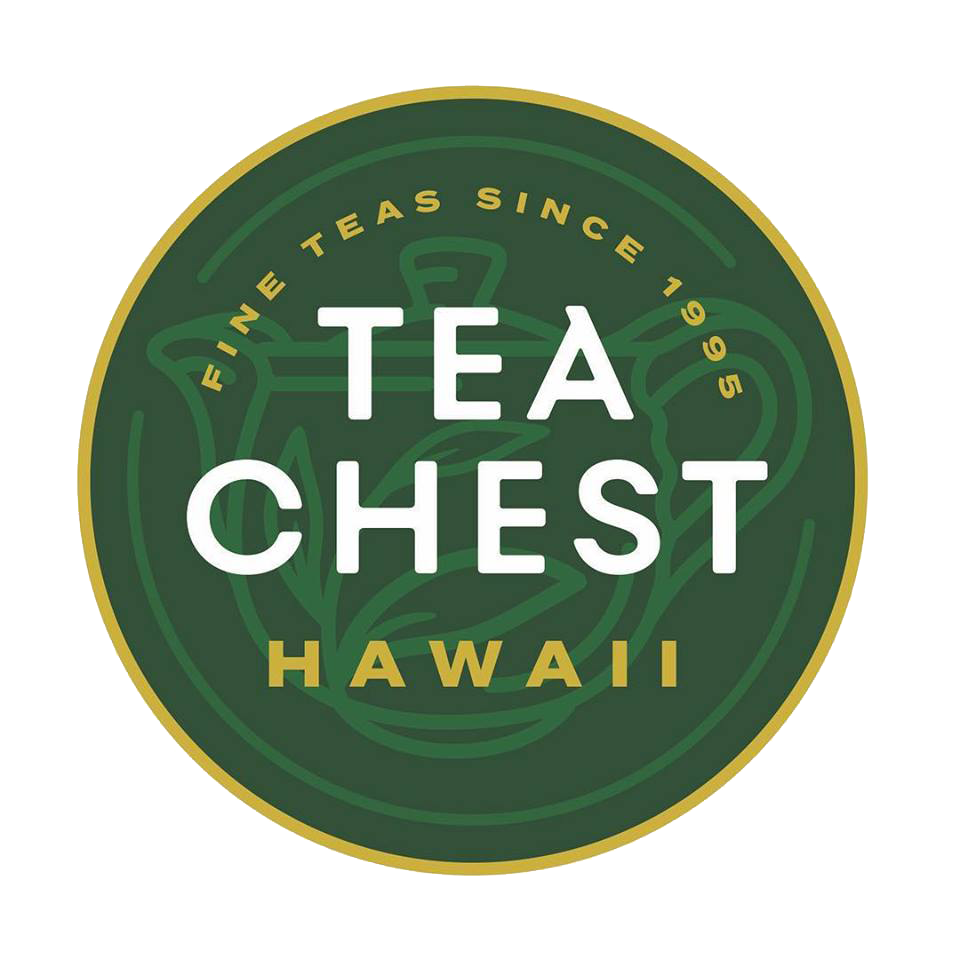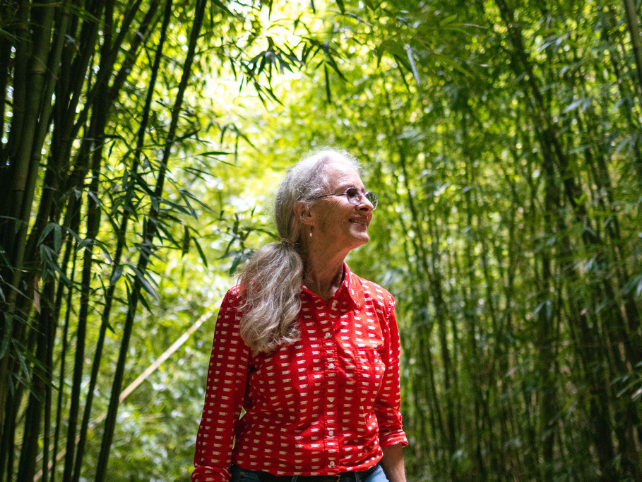The Pioneer Tea Farmer
Hawaii Tea Pioneers & Their Farm
Some of the finest loose leaf tea in the world is produced here in Hawaiʻi on the slopes of a volcano by Eliah Halpenny of Big Island Tea. Eliah and her partner Cam Muir established the farm in 2001. Before working on the farm, Eliah did agricultural landscaping for over 30 years. Eliah enjoys working in the field and with plants. She says that she could spend all day on a farm! Cam is a conservation geneticist and a professor at the University of Hawaii-Hilo with over 30 years of experience in ecology, evolutionary genetics and biochemistry. Their passion truly shows in the time and effort that goes into making an artisanal craft tea that can’t be found or replicated anywhere else!

The farm is part of a living tropical rainforest ecosystem, unmatched and unparalleled compared to any other tea farm in the world. The property sits on a 400 year old bed of volcanic ash surrounded by an ʻohia forest and other trees such as bananas and kukui. This native forest has shaded and nourished the soil for centuries, filling it with nutrients and rich biomaterial which affects the taste of the tea.
The tea plants bathe in cool morning mists that come off of Mauna Loa and are shaded from the afternoon sun by the surrounding native trees. Each plant is seed-grown promoting genetic diversity and agricultural sustainability. Natural cross-pollination takes place and no pesticides are used. This one-of-a-kind tea is plucked and processed entirely by hand.
Aʻa Black Tea is sold in distinguished stores such as Harrods of London and is served at esteemed establishments like Restaurant Senia, MW Restaurant and Eleven Madison Park.
“Tea is an art” - Eliah Halpenny

Every step that Eliah takes in making black tea is meant to achieve the best tasting tea in the world. The tea processing steps are harvesting/ plucking, withering, rolling, oxidizing and firing/ drying. At Big Island Tea, farmers pluck tea for about 2 hours before starting the withering process in the withering room. Plucked tea come in all different shapes and sizes and different moisture content. Eliah works with two other farmers, one of them being her partner Cam, and a fellow passionate farmer from Mililani, Oʻahu, named Rachel, who moved to the Big Island specifically to work and help care for the tea farm in 2023. With their tea expert knowledge, they each decide what tea leaves are best to pluck for making batches of tea, knowing that their tea farm contains a variety of tea that can make the tea taste different than others.
One of the main things that makes Big Island Teas ʻAʻa Black Tea so unique is the way that the tea is withered then rolled after oxidation. Traditionally, tea is rolled in a machine that has metal plates that rub together in a circular motion, shaping and breaking down the cell walls of the tea leaves in order to release and extract their aroma and juices. At Big Island Tea, the farmers use wooden rolling boards that have several ridges and a cloth to roll tea. Just like the harvesting and plucking process, Eliah and her partners use their hands to roll their tea, making it an experience of truly caring for and understanding the tea. When they do it, they place at least a handful of tea in the middle of the cloth and bring the ends of the cloth together and hold them firmly. They use their body weight to press the leaves in the cloth against the ridges of the board, not to the point where it damages the entire leaf, but enough to break the cell walls of the leaves to release the juices. The rolling process is done with great care, attention, and time in order to make exceptional, fine quality tea.
Firing is also a crucial step to making their tea taste amazing. Firing is meant to stop the oxidation process. Instead of drying the tea using a traditional hot air dryer, Big Island Tea uses the Orthodox Chinese Pan Firing Method with stainless steel wok. After rolling and oxidizing, the tea is gently tossed in the heated wok by hand until the tea's aroma is released. This pan-firing method is more labor intensive given that they do it manually with their hands. It’s clear that Big Island Tea puts extra care and attention in the details when it comes to producing their tea.
It’s More Than Just a Tea Farm
Eliah shared with our team from Tea Chest Hawaii that their farm produces better tea when there are other crops growing around it. She doesn’t call it a farm, but rather a forest and an entire ecosystem!

In their forest, they have kukui nut trees, which is also known as the candlenut tree due to the kukui nuts being able to produce oil and were used for lighting oil lamps back then. In addition, they have banana trees around the forest that also produce the mulch they have started utilizing to fertilize their tea plants. Eliah and Cam have found that banana mulch is healthy for their crops because it adds nutrients to the soil such as potassium, phosphorus, and organic matter. Furthermore, banana mulch is known to have lots of moisture and water, which also increases the moisture retention that supports the tea’s growth.
The trees and plants around the farm provide natural shade covering to the tea plants. Shade-growing tea allows for the plant to concentrate its many nutrients in the leaf, while also achieving a lovely and balanced flavor profile between the bitter catechins and sweet L-theanine.
The tea experts of the tea forest have for years been researching, taking notes, and are always trying to find what natural methods are best for the tea and entire ecosystem. They learned that restoring the forest has been a very beneficial method for their crops because everything in it works together. More crops and plants = more nutrients, pest control, shade, weed prevention, and increased soil health. Even though it is more labor, this shows how adamant they are about quality, taste and much they malama the ʻāina (land)!
Big Island Farming is One of a Kind
The Big Island (also called Hawaii Island) soil and weather conditions makes tea made in Hawaii unique and like no other!
One of the key differences between the Big Island and other places that grow tea is its volcanic activity that makes the soil much more mineral-rich. On the Big Island, there are two volcanoes named Kilauea and Mauna Loa, which have continuously erupted and added new volcanic material to the island. Basaltic lava, which dominates the volcanic activity on the Big Island, contains minerals such as olivine, pyroxene, and feldspar. As the lava breaks down, these minerals become part of the soil. The minerals contribute to the soil's nutrient composition, enhancing its fertility and pH levels, and supports plant growth.
In addition, the climate and rainfall are very diverse on Hawaii Island due to its large size and varied topography, ranging from arid regions to rainforests. The eastern side of the island, influenced by trade winds, receives more rainfall, leading to the development of wetter and more fertile soils, providing lots of moisture for crops.
Big Island Tea and many other tea farms on Hawaii Island rarely need to water their tea plants due to the moisture content that the land and unique environment provides. Still, tea experts in Hawaii handle their crops with great care and make sure the tea leaves do not get too crisp on hot days, like during the Summer, or on days when there is not much rain. The benefits of volcanic soil and the natural remedies that farmers use to make sure their tea plants are being preserved makes fine tea that is made all-natural thanks to Hawaii’s geological location.

Overall, the Big Island Tea farm stands as a shining example of dedication, expertise, and a deep passion for producing high-quality tea. Through Eliah and Cam’s meticulous cultivation practices, unwavering commitment to sustainability, and respect for the land, they have achieved the remarkable feat of crafting teas that embody excellence in every sip. Their focus on quality control, from hand-picking the finest leaves to employing innovative processing techniques, ensures that each tea produced is a testament to their pursuit of perfection.
Pioneering A New Industry
In 2012, Tea Chest Hawaii received a USDA grant to spur the development of tea as a new specialty crop grown in the United States. Knowing their passion and understanding of growing tea in Hawaii, Tea Chest Hawaii turned to Big Island Teas to be the lead propagator for the project. Over the course of 4 years, Big Island Tea propagated 66,246 new tea plants that were distributed to 25 farms to grow tea on 5 different islands. By 2016, the project doubled both the number of tea plants in the ground and the number of acres of the crop.
Written by Sage Marume & Byron Goo
Photos by Maia Mills
Source Links:
- https://www.teawithme.com.au/pan-fired-vs-steam-tea/
- https://serenitybrew.com/what-does-it-mean-that-green-tea-is-pan-fried/
- https://freshcup.com/chinese-tea/
- https://www.thomasnet.com/articles/other/how-is-tea-made/
- https://blog.englishteastore.com/2010/11/22/processing-tea-by-hand-or-machine/
- https://www.avoury.com/de/en/magazine/why-tea-leaves-are-rolled
- https://www.teaformeplease.com/how-tea-is-made-rolling/


Share:
Mamaki: Hawaiian Super Plant
Tea For Beauty